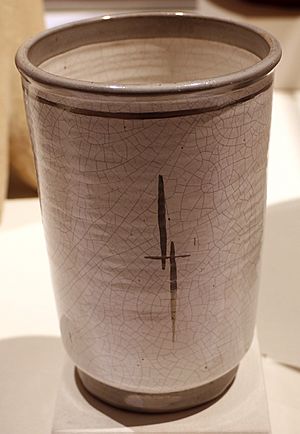Maija Grotell facts for kids
Maija Grotell (born August 19, 1899 – died December 6, 1973) was an important Finnish-American artist. She was famous for her ceramic art and for teaching others. Many people call her the "Mother of American Ceramics." This shows how much she influenced pottery in the United States.
Contents
Early Life and Learning
Growing Up in Finland
Maija Grotell was born in Helsinki, Finland. She studied at the University of Art and Design Helsinki. This school was located in a building called the Ateneum. Maija studied there for six years after finishing her first degree.
To pay for her studies, Maija worked as a textile designer. She also worked for the Finnish National Museum. After she finished school, she could not find a job in Finland. So, in 1927, she moved to New York, in the United States.
She chose the United States because it had more chances for artists. It was also easier for women to work there. Maija later said that she found a job very quickly. She had a job just three days after arriving in New York.
Starting in the United States
During her first summer in the U.S., Maija Grotell visited Alfred University. She went there to learn from a famous potter named Charles Fergus Binns. However, Maija and Binns had different ideas about teaching. Maija loved using the potter's wheel. Binns preferred other ways of making pottery.
At that time, using a potter's wheel was not common in the U.S. American potters often used methods like coiling or slip casting. Maija Grotell helped bring the potter's wheel technique to America. Other European artists like Gertrude and Otto Natzler also helped.
Maija's skill with the potter's wheel was very helpful. She was often asked to show how to use it. This made it easy for her to find teaching jobs in New York City.
Working at Cranbrook Academy of Art
In 1938, Maija Grotell got a job at the Cranbrook Academy of Art. This school is in Bloomfield Hills, Michigan. She became the head of the ceramics program there.
Maija was not sure about taking the job at first. The school had wanted a male teacher. When they offered her the job later, she worried. She was a single woman and feared losing her independence. She also worried that people might give credit for her success to her male co-workers.
At Cranbrook, Maija Grotell mostly worked with high-fire glazes. She also used stoneware clay. She loved to experiment during her thirty-year career. She tried many different glaze chemicals, kilns, and types of clay.
Her glaze recipes are still very important today. They influenced many students. Her glazes even helped ceramics be used in buildings. Her friend, Eero Saarinen, used her glazes for the outside of the General Motors Technical Center.
Maija as a Teacher
Maija Grotell was a very creative and dedicated teacher. She did not want her students to just copy her work. Instead, she encouraged them to find their own unique style.
Maija was known for working all night in the studio. She would make her own ceramics after teaching all day. Then, she would quickly go home to change clothes. She would return to the studio before anyone else arrived.
Her hard work eventually affected her health. In the early 1960s, she developed a muscle problem. This made it hard for her to use the potter's wheel. It also affected how much art she could create.
Maija retired from Cranbrook in 1966. By then, she had made the ceramics department one of the best in the U.S. She taught many important ceramists. Some of her famous students include Marie Woo, Toshiko Takaezu, and John Parker Glick.
Awards and Artworks
Maija Grotell faced many challenges because she was a single woman. But she was very successful. In 1929, she won the Diploma di Colabrador at an exhibition in Barcelona. In 1936, she was the first woman to win a prize at the Ceramic National event. In 1938, she was named a master craftsman.
In 1937, she won a silver medal at the Paris International Exhibition. Her art was shown all over the country. This was special because ceramics were not often shown in art exhibits back then. She continued to take part in the Ceramic National every year from 1933 to 1960.
Today, you can find Maija Grotell's work in many famous museums. These include the Metropolitan Museum of Art, the Brooklyn Museum, and the Museum of Fine Arts, Boston. Her art is also in the Detroit Institute of Arts and the Art Institute of Chicago.
See also
 In Spanish: Maija Grotell para niños
In Spanish: Maija Grotell para niños



